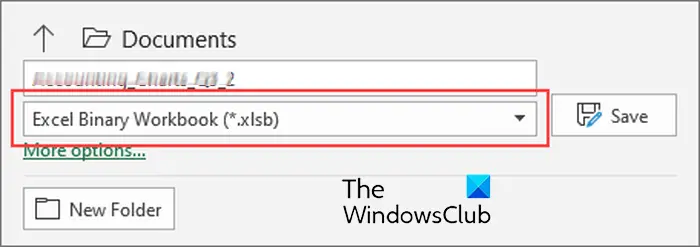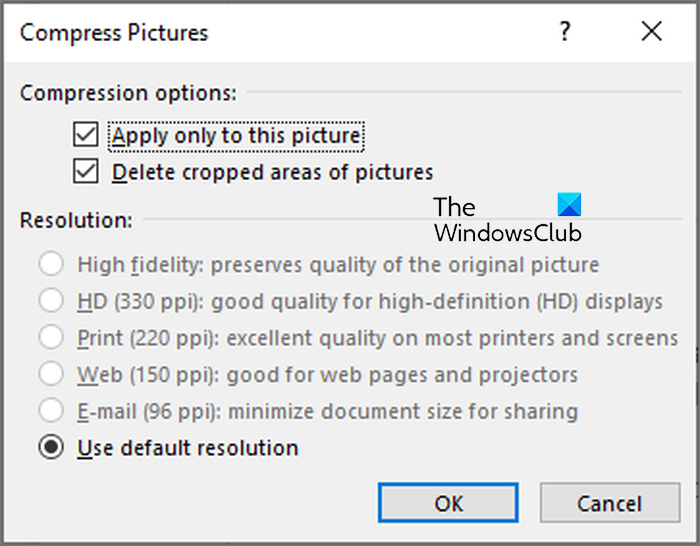Here are some methods to reduce the size of an Excel file on Windows 11/10. A lot of users have reported experiencing issues due to the large size of their Excel workbook. While loading the file, Excel keeps lagging or freezing. Huge file size also creates difficulty in sharing the file with others. Now, several factors can increase the size of your Excel file. Let us find out these reasons.

Why is my Excel file size so large?
One of the main reasons is high-quality images added to your sheet. Apart from that, the pivot cache that is auto-generated when you add a pivot table is another reason behind large-sized Excel files. Other reasons for the same include excess formatting, too much data, embedded objects, and too many worksheets added in a single workbook.
How to reduce the size of an Excel file?
If the size of your Excel workbook is too large, you can use the below tips and tricks to reduce the size of the Excel file:
- Save your spreadsheet as Excel Binary Workbook.
- Remove unnecessary worksheets, data, and unused formulas.
- Compress added image files.
- Don’t store the pivot cache with your Excel file.
- Remove formatting from your workbook.
- Delete Watch.
- Compress the Excel file using a dedicated tool.
1] Save your spreadsheet as Excel Binary Workbook

The first tip that we would like to share to reduce the size of your Excel file is to save the workbook in Excel Binary Workbook (XLSB) format instead of XLS or XLSX format. This format saves the workbook in a much lesser size because it saves data in binary format than XML-based format.
Do note that XLS and XLSX formats are more widely used formats and work with most third-party spreadsheet programs. However, the binary format is fine if you are using the file only with Microsoft Excel or other software that support the XSLB format.
To save your spreadsheet as Excel Binary Workbook, follow the below steps:
- First, open the source Excel file and click on the File > Options > Save option.
- Now, set the output format to Excel Binary Workbook (.xlsb) and press the Save button.
2] Remove unnecessary worksheets, data, and unused formulas
You can also try deleting unnecessary worksheets with no relevant or significant data from your workbook. Right-click on the sheet tab from the bottom and choose the Delete option. Besides that, you can also clear unwanted data and formulas to reduce the size of your Excel file.
3] Compress added image files

Want to further reduce the size of your Excel file? Well, try compressing the image files added to your spreadsheet. Images with higher resolution increase the file size of the Excel workbook. So, reduce the size of embedded images and it will automatically reduce the size of the Excel file.
Here’s how to do that:
- First, select an image in your Excel file and go to the Picture tab.
- Now, click on the Compress Pictures button under the Adjust group.
- Next, tick the Apply only to this picture (select according to your requirement) and Delete cropped areas of pictures checkboxes.
- After that, click on the Use default resolution option under Resolution.
- Finally, press the OK button to compress all your images.
Read: Excel cannot open two workbooks with same name at same time.
4] Don’t store the pivot cache with your Excel file

You can also remove the pivot cache from your workbook to reduce the Excel file size. When you create a pivot table in your workbook, Excel automatically creates a Pivot Cache that basically stores a replica of the data source. While it is helpful during the process, it increases the file size. So, you can delete the pivot cache to get the file size of your Excel workbook decreased.
To do that, click on a cell in your pivot table and then go to the PivotTable Analyze tab. Now, under the PivotTable group, choose Options and move to the Data tab in the appeared dialog window. Next, uncheck the options called Save source data with file and Refresh data when opening the file.
Need more tips to reduce the file size of an Excel workbook? Move on to the next tip.
See: How to remove Metadata from Excel sheet?
5] Remove formatting from your workbook
If possible, you can remove formatting from your spreadsheet to reduce the size of an Excel file. Formatting is useful to make your workbook more comprehensive and informational. However, it also increases file size significantly. So, if you have the option to delete all the formatting, do that, and it will automatically decrease the file size of a larger Excel workbook.
To do that, you can go to the Home tab and click on the Clear > Clear Formats option under the Editing group. This will remove formatting from selected cells.
Read: Batch Compress PDF files using free software and online tools.
6] Delete Watch

Excel provides a Watch Window using which you can easily inspect, audit, or confirm formula calculations and results in a large workbook with multiple worksheets. However, it can increase your file size. So, when you are done with watches, you can remove them.
To delete a watch in Excel, go to the Formulas tab and click on the Watch Window option. Now, select added watches and press the Delete Watch button.
7] Compress the Excel file using a dedicated tool
If it seems tiring to manually reduce the size of an Excel file, we recommend using a third-party tool. There are plenty of online tools and desktop applications that help you reduce the size of different types of files including Excel files. If you are looking for a free one, we would recommend using ClipCompress. It is a good online tool using which you can decrease the size of XLS and XLSX files.
I hope this post helps you reduce the size of Excel files.
What software reduces Excel file size?
If you want to reduce the size of an Excel file offline, you can use a desktop application. There are some file compression software that also let you decrease Excel file size. To name some, you can use NXPowerLite or Excel File Size Reduce Software by Sobolsoft. These are paid software with a trial version. If you want a free tool to reduce Excel file size, use free online tools like WeCompress or ClipCompress.
Now read: How to compress and reduce the size of a Word document?
Leave a Reply